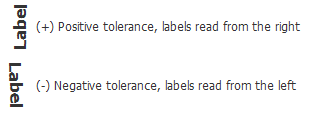In addition to the parameters you can set to control the labeling of individual label classes, ArcGIS has global parameters you can use to control how labels are placed for all layers when using the Standard Label Engine. These settings are saved for each data frame in your map.
Unplaced label color
This controls the color of the labels that could not be placed on the map. By default, unplaced labels are drawn in red. If your map already contains many red labels, you can change the color of the unplaced labels to something different.
Data frame rotation
You can rotate data frames of a map using the tools on the Data Frame toolbar. This controls whether point and polygon labels will be rotated when the data frame is rotated.
Line labels, non-horizontal polygon labels, and non-Maplex Label Engine point labels based on a field value will always rotate with the data frame.
Non-horizontal polygon labels will always rotate with the data frame because they have the potential to be placed at the best polygon angle. Therefore, after data frame rotation the labels are replaced, which means that they are effectively rotated to the new polygon feature orientations.
Orientation of vertical labels
Labels are typically placed to read from left to right, following the convention of most western languages. When labeling nearly vertical line features, the natural break point would be at 0 degrees, or due North. In places where the streets are laid out in a North–South/East–West-oriented grid, the labels of nearly parallel streets may be placed in opposite directions. This may be reasonable for reading the map on a computer screen, but for printed maps, it is desirable that nearly parallel streets be labeled in the same direction.

The orientation of a vertical label's angle controls whether the label is placed slightly upside down or flipped to the opposite direction. A small angle prevents labels from switching their reading order when labeling nearly vertical lines. Specify a positive value if you want labels that are close to vertical to generally read from the right side of the page or screen, and a negative value if you want these labels to generally read from the left. For example, suppose you have two lines, one of which is oriented 6 degrees East of North and the other of which is oriented 6 degrees West of North. The first will have a label that is read from South to North (left to right). If you specify an angle of 0, the label of the second line would be flipped to read from North to South, rather than have it placed slightly upside down. If you would prefer to have some labels go slightly upside down to keep a consistent reading direction, increase the angle—in this case, to more than 6 degrees. Using a negative angle forces the labels to change direction at a given angle East of North. The default angle is 5 degrees, and the maximum angle is 30 degrees. The angle also applies to North–South-oriented polygons or their boundaries when using the Straight and Boundary label positions.